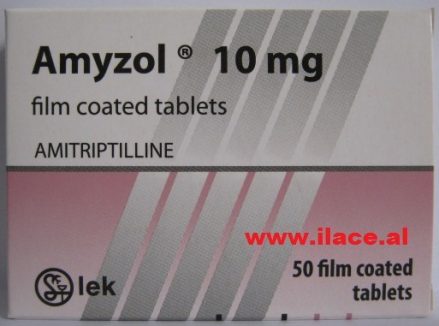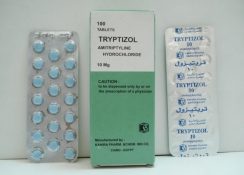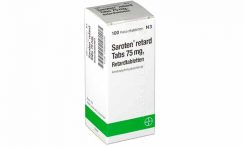Depression is a terrible disease that “eats” the human spirit and turns life into a dumb gray movie. For a long time this disease has become a scientifically proven mental disorder that requires proper medical treatment. Amitriptyline tablets are one of the most commonly prescribed and effective drugs in the fight against depression.
Material Content:
Composition of Antidepressant
By its chemical nature, amitriptyline is a tricyclic antidepressant, that is, the molecules of the substance consist of three carbon rings. He is the main representative of this class of antidepressants along with Imipramine and Clomipramine. The principle of the drug’s action is based on the process of reducing the rate of capture of various neurotransmitters (chemicals with which an impulse is transmitted between nerve cells).
For ease of administration, amitriptyline is produced in tablets, which are coated with a special shell.
In the composition of each capsule:
- the main substance is amitriptyline hydrochloride;
- auxiliary components are magnesium stearate, povidone, talc and cellulose with starch.
In addition, the manufacturer uses propylene glycol and hypromellose in the capsule shell. Amitriptyline dosage in tablets has a different - 10 and 25 mg. They look the same - biconvex, white. You can buy the medicine in plastic blisters or in a glass bottle, with each package containing detailed paper instructions.
Pharmacological properties and pharmacokinetics
The anxiolytic effect of the drug is based on the ability of amitriptyline to reduce the rate of neurotransmitter retention by cells of nerve endings. Due to this, chemical reactions and the transmission of impulses between cells are faster, thereby strengthening the connection between neurons in the central nervous system (central nervous system).
In addition, regular use of the drug allows you to:
- Increase the production of neurotransmitters by the body.
- Strengthen brain neurons.
- Increase the amount of norepinephrine and serotonin.
- Accumulate monoamines.
- Normalize the work of the serotonin system of the body.
Due to its chemical composition, amitriptyline has an antidepressant and sedative effect, that is, it calms the patient and improves mood, easing depression. Its regular use allows you to reduce (dull) bouts of anxiety and fear, constant anxiety.
They take the drug orally, because it is most rapidly absorbed from the digestive tract, while maintaining a high bioavailability of about 62% (nortriptyline up to 70%). 2 hours after administration in the blood, the maximum concentration of the drug is observed, and it persists for 7.5 hours. And the equilibrium concentration is observed after 7 days of regular treatment. Metabolites are completely excreted along with urine through the kidneys and bile ducts.
The drug easily passes through cellular barriers (including histohematological and placental) due to strong binding to blood proteins (95%). After 2-6 weeks, the patient has a clinical decrease in depression.
What is Amitriptyline prescribed for?
Amitriptyline, the indications for use of which are identified by a psychotherapist, is prescribed only after a complete diagnosis of the patient and an accurate diagnosis.
Indication for the use of amitriptyline is primarily depression with a pronounced sense of anxiety, which is caused by various factors:
- endogenous;
- reactive;
- neurotic;
- medicinal.
Amitriptyline also helps with the diagnosis of:
- manic-depressive psychosis;
- emotional stress and frustration;
- sleep disturbances;
- bulimia;
- behavioral disorders.
Amitriptyline is also prescribed in the presence of enuresis in children if there are no problems with the urinary system. An antidepressant can be prescribed as a prevention of migraine.
Instructions for use and dosage of tablets
Before starting therapy with amitriptyline, it is necessary to stop taking MAO inhibitors for 2 weeks. Amitriptyline is not prescribed for patients with mania, since it can enhance obsessions and condition. And patients with a history of suicide attempts with this therapy must be supervised by psychotherapists and psychiatrists. Such patients, as well as elderly people and children, are prescribed a reduced dosage.
All other patients are prescribed the following:
- Take 20-25 mg per day for one or two doses for six months or more. The dosage over time (and according to need) increases and is brought up to 200 mg per day.
- Elderly patients take 25-30 mg of the drug once a day at the beginning of therapy. The maximum daily dose that is allowed for patients aged 55 years and older is 50-100 mg.
- With renal failure, the dose of the drug does not decrease, but with liver failure, the dose decreases and is prescribed by the doctor individually.
Most often, doctors prescribe Amitriptyline tablets 25 mg dosage, since it is so convenient to gradually increase the daily rate of the drug. Take Amitriptyline orally immediately after eating, drinking plenty of water (without chewing). If the desired therapeutic effect cannot be achieved within 4 weeks of therapy, then it should be reviewed and, possibly, changed or strengthened medicine. Usually, the course of treatment is six months or more in order to completely mitigate the symptoms of depression and prevent relapse.
During therapy, the use of alcohol is prohibited, and it is also not recommended to drive a car and operate heavy machinery. Typically, patients have distracted attention and loss of speed, accuracy, so driving and working with machinery can be dangerous. In order to avoid withdrawal syndrome, therapy is completed slowly, gradually reducing the dosage.
Alcohol compatibility
Like any antidepressant, Amitriptyline can not be taken with alcohol, and in any quantities and any strength. It is generally better for patients with mental disorders to stop drinking alcohol, since alcohol affects the central nervous system, exacerbating the disorders and diseases, while unpredictably changing human behavior.
With the simultaneous administration of this antidepressant and alcohol, the effect of the drug is completely leveled, while exacerbating anxiety, a sense of fear and depression in general. Combining antidepressant and alcohol is strictly prohibited!
Drug interaction
Amitriptyline is a representative of the tricyclic antidepressant group, therefore, it is not prescribed together with other drugs of this chemical group. It should not be combined with selective reuptake inhibitors, as this can cause serotonin syndrome.
When combining different therapies, the following reactions were identified:
- The inhibitory effect on the nervous system when combining Amitriptyline and antipsychotics, analgesics, as well as sleeping pills and sedatives.
- Mutual enhancement of the effects of amitriptyline when taken with other antidepressants.
- The development of bowel obstruction and febrile temperature when combining an antidepressant with antipsychotics.
- Heart rhythm disturbances and the occurrence of tachycardia when taking adrenaline stimulants and amitriptyline.
- The weakening of anticonvulsants while taking with this medicine.
If depression was caused by glucocorticoids, then amitriptyline will exacerbate the disease and all its symptoms. Doctors also do not recommend the simultaneous administration of an antidepressant with digitalis-based medicines.
Contraindications, side effects and overdose
Amitriptyline should not be used immediately after completion of the course of MAO inhibitors, as well as after myocardial infarction.
In addition, contraindications to this therapy are:
- allergy to the components of the drug;
- heart dysfunction;
- prostatic hyperplasia (benign and malignant);
- atony of the bladder;
- chronic bowel obstruction;
- ulcerative lesions of the gastrointestinal tract;
- violation of the kidneys and liver (reception is possible with dosage adjustment);
- leukemia.
Oral administration of the drug is allowed only from 6 years old, and injectable - from 12. In addition, epilepsy, heart rhythm disturbance, glaucoma and hyperthyroidism will become a limitation to full therapy. When taking Amitriptyline, unpleasant side effects may occur.
Among them:
- dryness in the nasopharynx and staining of the tongue in blue;
- problems with urination;
- irritability;
- general weakness;
- profuse sweating;
- nightmares and loss of concentration;
- fainting
- decreased libido.
When taking the medicine, allergic reactions in the form of rhinitis, intestinal problems, rashes and peeling on the skin can occur.
If medical recommendations are not followed, the patient may experience an overdose of the drug, which is accompanied by convulsions, hallucinations, hypothermia and impaired cardiac activity. In case of overdose, the patient should immediately rinse the stomach and prescribe symptomatic therapy, while observing it in a hospital for up to 5 days in order to avoid relapse.
OTC drug analogues
By their chemical structure, amipriptyline analogues and representatives of the first generation of antidepressants are imipramine and clomipramine, but they are sold only by prescription. It should be understood that antidepressants are serious drugs that can cause significant harm to health, so a very small number of such drugs can be purchased without a medical prescription. Any structural analogue of Amitriptyline, which in its composition has the same active substance, is dispensed according to a medical prescription.
Among them:
- Amizole;
- Sarotin Retard;
- Elivel;
- Tryptisolum.
To date, Amitriptyline is the most effective antidepressant, which is included in the list of medicines recommended by the World Health Organization. At the same time, its cost is extremely low, so this medication is available to a wide range of buyers.

























